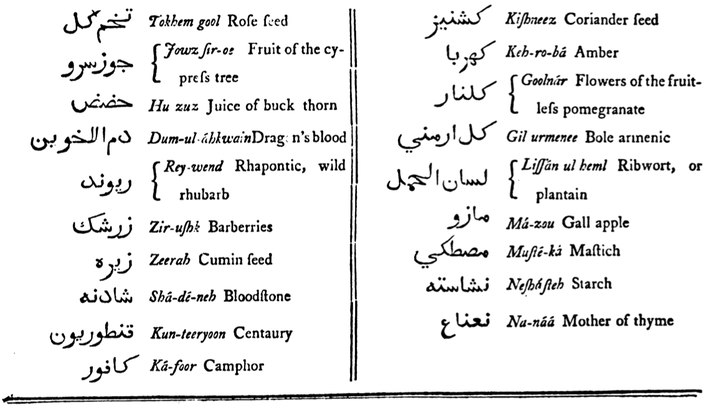Sentry Page Protection
2P. Hemostatics
Styptics; Medicines that Stop Bleeding.
Materia Medica in Arabic & Persian, Shirazy, 1793
These are medicines which stop bleeding. In general, Bleeding may be either of a Heat type or Cold type.
Types of Bleeding:
1. Heat-type Bleeding–In this case the Blood is bright red, fresh and flows freely. It is seen in either i. Febrile Disease (ie. Hemorrhagic Fever); ii. Infectious Diseases (ie. Bloody Dysentery); iii. certain Menstrual Diseases. The person will usually have heat symptoms unless the condition is chronic which progresses to a case of Blood deficiency which usually comes with other deficiency (Qi, Yin etc.)
2. Cold-type Bleeding–Cold or Passive Bleeding has pale or watery looking blood, is not so active, and is usually seen in deficient cases.
3. Bleeding from Trauma–Trauma can cause Bleeding which may be either External or Internal. Medicines to stop bleeding are usually combined with Vulnerary herbs in this case. It is also important to treat the underlying nature. If the person presents with Heat symptoms, use more cooling herbs, whereas Warm hemostatics should be used in one who is cold by nature.
Types of Hemostatic Medicine
Hemostatic medicines can work in several different ways:
1. Astringent medicines which close the mouth of the vessels.
2. Drugs that are thick and mucilaginous, and therefore enhance coagulation.
3. Cold medicines that stop inflammatory bleeding.
4. Medicines which divert Blood flow.
5. Narcotics which slow blood flow and relieve bleeding.
Examples of Primary Hemostatic Medicines
1. Carbonised Roots–several roots are used in their carbonised forms, both in TCM and Traditional European Medicine. Carbonised roots of Madder, Rhubarb, Burnet and Ginger are examples.
2. Iron Containing Medicines–several Iron-containing medicines have long been used to stop bleeding. They have the advantage of also supplying iron to nourish the lost blood. Red Earth, Hematite and Red Coral are examples.
3. Blood Regulating Medicines–some medicines move the Blood when obstructed, but can also stop bleeding, thus being true regulators. Notoginseng San Qi, Madder, Dragon's Blood, Yarrow and St. John’s Wort are examples
4. Astringents–a number of astringent medicines also have a secondary hemostatic effect.
Compare with the TCM classification L .Medicines to Stop Bleeding
Types of Bleeding:
1. Heat-type Bleeding–In this case the Blood is bright red, fresh and flows freely. It is seen in either i. Febrile Disease (ie. Hemorrhagic Fever); ii. Infectious Diseases (ie. Bloody Dysentery); iii. certain Menstrual Diseases. The person will usually have heat symptoms unless the condition is chronic which progresses to a case of Blood deficiency which usually comes with other deficiency (Qi, Yin etc.)
2. Cold-type Bleeding–Cold or Passive Bleeding has pale or watery looking blood, is not so active, and is usually seen in deficient cases.
3. Bleeding from Trauma–Trauma can cause Bleeding which may be either External or Internal. Medicines to stop bleeding are usually combined with Vulnerary herbs in this case. It is also important to treat the underlying nature. If the person presents with Heat symptoms, use more cooling herbs, whereas Warm hemostatics should be used in one who is cold by nature.
Types of Hemostatic Medicine
Hemostatic medicines can work in several different ways:
1. Astringent medicines which close the mouth of the vessels.
2. Drugs that are thick and mucilaginous, and therefore enhance coagulation.
3. Cold medicines that stop inflammatory bleeding.
4. Medicines which divert Blood flow.
5. Narcotics which slow blood flow and relieve bleeding.
Examples of Primary Hemostatic Medicines
1. Carbonised Roots–several roots are used in their carbonised forms, both in TCM and Traditional European Medicine. Carbonised roots of Madder, Rhubarb, Burnet and Ginger are examples.
2. Iron Containing Medicines–several Iron-containing medicines have long been used to stop bleeding. They have the advantage of also supplying iron to nourish the lost blood. Red Earth, Hematite and Red Coral are examples.
3. Blood Regulating Medicines–some medicines move the Blood when obstructed, but can also stop bleeding, thus being true regulators. Notoginseng San Qi, Madder, Dragon's Blood, Yarrow and St. John’s Wort are examples
4. Astringents–a number of astringent medicines also have a secondary hemostatic effect.
Compare with the TCM classification L .Medicines to Stop Bleeding
Western Classification


